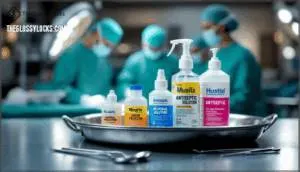This site is supported by our readers. We may earn a commission, at no cost to you, if you purchase through links.

Effective skin preparation isn’t simply swabbing antiseptic across the surgical field; it requires removing surface contaminants, eliminating pathogens residing in deeper dermal layers, and establishing a sustained antimicrobial barrier that persists throughout the procedure. Master these best skin preparation methods, and you’ll markedly shift the odds in your patient’s favor.
Table Of Contents
- Key Takeaways
- Why is Skin Preparation Crucial for Surgery?
- Key Steps in Preoperative Skin Preparation
- Choosing The Right Antiseptic Solution
- Best Practices for Applying Antiseptics
- Maintaining Compliance With Skin Prep Protocols
- Frequently Asked Questions (FAQs)
- What is surgical site skin preparation?
- What is skin prep?
- How do you prepare a patient’s skin for surgery?
- Why is skin preparation important during a surgical procedure?
- What is the standard of practice for patient skin prep?
- How is skin prep done?
- What materials should be used for drip towels?
- How often should clippers be replaced or maintained?
- Can antiseptics cause allergic reactions in patients?
- What temperature should the OR be maintained at?
- Conclusion
Key Takeaways
- Surgical site infections affect roughly 5% of clean-contaminated operations and increase mortality risk 2–11 times, making proper skin preparation your most critical defense against preventable complications that extend hospital stays and drive billions in healthcare costs.
- Chlorhexidine gluconate consistently outperforms povidone-iodine in reducing infection rates (3.0% versus 4.8%), offering faster bactericidal action, longer-lasting antimicrobial effects, and resistance to blood inactivation during procedures.
- Effective preparation requires three interconnected steps—removing surface contaminants through preoperative cleansing, eliminating deep dermal pathogens with proper antiseptic application, and establishing a sustained antimicrobial barrier through complete drying (minimum 2 minutes) before draping.
- Compliance failures undermine even the best protocols, with national data showing proper antiseptic application occurs in fewer than 50% of cases, making systematic staff training, regular audits, and annual guideline updates essential for consistent patient safety outcomes.
Why is Skin Preparation Crucial for Surgery?
Surgical site infections remain one of the most serious threats to patient safety, affecting approximately 5% of all clean-contaminated operations. Your skin’s natural microbiome—bacteria, fungi, and viruses—can turn against you during surgery if not properly managed.
Let’s examine the three critical reasons why thorough skin preparation isn’t just protocol, it’s your first line of defense.
Impact of Surgical Site Infections
Surgical site infections aren’t just a complication—they’re a defining threat to patient safety and healthcare policy. SSIs complicate up to 30% of certain procedures, driving infection control efforts worldwide.
You’re facing a 2–11 times higher mortality risk when SSIs occur, with hospital stays extending 10–11 days. The economic burden reaches $3.3 billion annually in the U.S. alone, making SSI prevention essential for patient outcomes and surgical skin preparation protocols.
Surgical site infections multiply mortality risk up to eleven times and cost healthcare $3.3 billion annually, making rigorous skin preparation non-negotiable
Effective infection control strategies are vital to reducing the risk of surgical site infections.
Goals of Effective Skin Preparation
Your surgical team’s preparation protocol must achieve three interconnected objectives: remove transient surface contaminants, eliminate pathogenic microorganisms residing in deeper skin layers, and create a sustained antimicrobial barrier that prevents recolonization throughout the procedure. Effective preoperative skin preparation meets these targets through systematic microbe removal and strategic antiseptic solution application.
- Skin cleansing eliminates dirt, oils, and surface debris that harbor bacteria
- Skin disinfection targets resident flora in sebaceous glands and hair follicles
- Antiseptic efficacy extends beyond application, maintaining infection control throughout surgery
- Sustained antimicrobial activity prevents bacterial regrowth during lengthy procedures
- Patient safety improves when surgical skin preparation protocols achieve all three objectives simultaneously
Patient Safety and Infection Prevention
When your team implements these thorough preparation measures, you directly address one of healthcare’s most persistent challenges: surgical site infections that affect approximately 5% of all clean-contaminated operations.
These protocols don’t just reduce medical error reduction rates—they transform patient outcomes by breaking the chain of microbial transmission.
Your commitment to infection prevention through rigorous surgical hygiene creates a protective shield around vulnerable patients, demonstrating antimicrobial stewardship that prioritizes patient safety above convenience.
Key Steps in Preoperative Skin Preparation
Before you step into the operating room, your skin needs three essential layers of defense. Preoperative cleansing removes surface contaminants, strategic hair removal minimizes bacterial reservoirs, and proper draping creates a sterile barrier that holds throughout your procedure.
Here’s how each step protects you from infection.
Preoperative Cleansing Techniques
Think of preoperative cleansing as your first line of defense—a simple shower with plain soap can dramatically reduce the microbial load on your skin and set the stage for a safer surgical outcome.
You’ll want to focus on thorough patient hygiene, washing the surgical site and surrounding areas to remove dirt, oils, and transient microorganisms.
This fundamental skin cleansing step establishes the foundation for effective skin antisepsis, guaranteeing subsequent antiseptic solutions work optimally during your surgical skin preparation protocol.
Best Practices for Hair Removal
If hair removal is necessary for your procedure, timing and technique matter more than you might think—done wrong, it can actually increase your infection risk rather than reduce it.
You should use clippers with disposable heads immediately before surgery, avoiding preoperative shaving that traumatizes skin and creates bacterial entry points.
Hair clipping technique for scalp preparation, facial hair, or body hair should happen as close to incision time as possible—ideally right before you’re brought to the OR—to minimize microbial colonization of microscopic skin abrasions.
Proper Draping Methods
After disinfection dries completely, strategic draping creates a sterile barrier that shields your prepared skin from contamination throughout the procedure. You’ll want to:
- Position sterile drapes immediately after drying protocols confirm complete evaporation
- Consider iodophor-impregnated incise drapes to actively suppress skin recolonization during lengthy operations
- Maintain sterile technique throughout drape placement to preserve your thorough preoperative skin preparation
Proper surgical site preparation isn’t complete until draping secures the antiseptic’s antimicrobial advantage.
Choosing The Right Antiseptic Solution
Selecting the right antiseptic isn’t just about grabbing what’s available—it’s about understanding which solution delivers the most effective microbial reduction for your specific surgical scenario.
Different antiseptics offer distinct advantages in antimicrobial spectrum, duration of action, and compatibility with various tissue types.
Let’s break down your options so you can make an informed choice that prioritizes patient safety.
Alcohol-Based Vs. Non-Alcohol-Based Solutions
Your choice between alcohol-based and aqueous antiseptic solutions directly impacts antiseptic efficacy and infection rates during preoperative skin preparation. Alcohol-based solutions deliver enhanced skin disinfection with faster microbial reduction, making them the preferred standard for surgical site preparation in most settings.
However, you’ll need to weigh this benefit against skin irritation risks—affecting roughly 5% of patients—and fire risks that demand strict drying protocols of 3–5 minutes before draping. The use of alcohol based preparations is supported by clinical guidelines for reducing surgical site infections.
Chlorhexidine Gluconate Vs. Povidone-Iodine
You’ll find that chlorhexidine gluconate consistently outperforms povidone-iodine in surgical outcomes and infection control. Meta-analyses show chlorhexidine reduces overall SSI rates to 3.0% compared to povidone-iodine’s 4.8%—a meaningful difference in microbe resistance and antiseptic efficacy.
Chlorhexidine’s enhanced skin disinfection stems from its faster bactericidal action, longer-lasting effect, and resistance to blood inactivation. While povidone-iodine costs less upfront, chlorhexidine’s preoperative skin preparation advantages make it the stronger choice for most skin prep techniques.
Selecting Antiseptics for Special Procedures
When prepping delicate tissues—think mucous membranes, eyes, or open wounds—the antiseptic rules change completely. Alcohol-based formulations won’t work here; they cause stinging and tissue damage. Instead, you’ll need aqueous chlorhexidine gluconate or povidone-iodine for mucosal disinfection and ophthalmic precautions.
Don’t skip allergy screening before selecting your antiseptic agents—pediatric considerations matter too, as younger patients show heightened sensitivity to certain preoperative skin preparation solutions in established skin preparation protocols.
Best Practices for Applying Antiseptics
Applying antiseptic solutions properly isn’t just about following steps—it’s about protecting your patient from infection at one of their most vulnerable moments. The technique you use, the time you allow for drying, and the tools you choose all play critical roles in achieving effective skin disinfection.
Let’s break down the essential practices that separate adequate preparation from excellent outcomes.
Correct Application Techniques
Applying your antiseptic isn’t about speed—it’s about precision, coverage, and giving those microbes no place to hide. Use a back-and-forth motion, working outward from your incision site in overlapping strokes. This application pattern guarantees complete contact with every skin fold and contour.
Your skin prep tools—whether sterile applicators or soaked gauze—should deliver consistent antiseptic agents across the entire surgical field, following proper sterilization techniques and preoperative skin preparation protocols without gaps.
Ensuring Adequate Drying Time
You can’t rush chemistry—once the antiseptic hits your patient’s skin, it needs time to work its antimicrobial magic before you can safely drape and cut. Antiseptic evaporation rates matter: alcohol-based solutions require at least two minutes of drying time optimization to achieve full antimicrobial efficacy.
Don’t drape prematurely—wet antiseptic solutions pool, creating fire hazards and compromising your surgical site preparation.
Use of Applicators and Dye Visibility
Sterile applicators simplify your prep workflow, while dye-enhanced solutions let you verify complete coverage at a glance. These innovations transform surgical site preparation from guesswork into visible confirmation:
- Applicator design features polyurethane foam that maximizes antiseptic delivery and skin contact during preoperative skin preparation
- Single-use sterile packaging prevents cross-contamination while preserving chlorhexidine efficacy remains intact
- Dye-enhanced visibility marks the prepped area, so you’ll instantly spot gaps in antiseptic agent application
- Integrated alcohol-based formulations combine antiseptic agents for enhanced skin disinfectant performance using proven surgical skin preparation techniques
Maintaining Compliance With Skin Prep Protocols
Even the best protocols fail without consistent implementation. You need a clear system to guarantee your surgical team applies skin preparation techniques correctly every single time.
Three fundamental approaches can help you maintain compliance and protect your patients from preventable infections.
Staff Training and Education
Even the most intricate antiseptic protocol falls apart without a well-trained team that understands not just the ‘how’ but the ‘why’ behind each step. You need thorough training programs that reinforce staff competency through hands-on education materials focused on infection control measures in healthcare.
Regular sessions on surgical protocols and guidelines guarantee your team maintains compliance monitoring standards while connecting patient safety guidelines directly to infection control outcomes. Medical education and training must evolve with healthcare guideline implementation—making every team member a guardian of safety.
Regular Protocol Audits
Training alone won’t keep your team sharp—systematic audits transform compliance rates into measurable outcomes. Audit frequency matters: start with roughly 10 procedures per assessment period, then scale back as surveillance methods reveal consistent adherence.
Use objective audit tools like AORN’s Competency Verification or real-time dashboards that track surgical site preparation steps against infection control measures in healthcare.
National data shows proper antiseptic application happens in fewer than 50% of cases, which directly impacts surgical site infection prevention and patient safety guidelines.
Updating Guidelines for Improved Outcomes
Guidelines evolve constantly—if you’re not updating your protocols at least annually, you’re already behind the curve on evidence-based infection prevention.
Track patient outcome metrics and surgical site monitoring data to drive your guideline revision process. When infection control strategies shift, you’ll spot gaps fast—then integrate evidence-based updates on antiseptic solutions for skin disinfection that actually move the needle on patient safety and outcomes in real-world infection control measures in healthcare.
Frequently Asked Questions (FAQs)
What is surgical site skin preparation?
Surgical site skin preparation systematically removes transient microbes, dirt, and oils from the skin surface using antiseptic solutions.
This process reduces bacterial colonization, which could lead to postoperative infections and compromise patient outcomes.
What is skin prep?
Skin prep is your surgical shield—a systematic process of cleansing, disinfecting, and preparing the operative site using antiseptic solutions to eliminate transient microbes and reduce infection risk before any incision.
How do you prepare a patient’s skin for surgery?
Proper preparation starts with a preoperative patient shower using plain soap to remove surface debris. Hair removal follows using clippers—never razors—to prevent microabrasions.
Next, apply your chosen antiseptic solution in overlapping strokes, covering the surgical site and surrounding skin antisepsis zone, then allow complete drying before surgical draping begins.
Why is skin preparation important during a surgical procedure?
You don’t want to gamble with surgical site infections—they threaten patient safety and complicate recovery. Thorough skin preparation removes harmful microbes, dramatically reducing infection risk.
This critical step in infection control directly improves patient outcomes by creating the safest possible surgical environment.
What is the standard of practice for patient skin prep?
You’ll follow a three-part protocol: cleanse the patient’s skin preoperatively, remove hair only when necessary using clippers, then apply an alcohol-based antiseptic like chlorhexidine gluconate following strict Skin Prep Guidelines and infection control measures.
How is skin prep done?
You’ll start with preoperative cleansing using plain soap, then remove hair with clippers if needed.
Next, apply antiseptic solution—commonly chlorhexidine gluconate or povidone-iodine—in a back-and-forth motion, let it dry completely, and drape the site to maintain sterility.
What materials should be used for drip towels?
Like a safety net catching falling water, drip towels use absorbent materials—disposable towels made from medical fabrics—to capture excess antiseptic agents during skin preparation.
These surgical absorbents prevent iodophors or other solutions from pooling near the surgical site preparation area.
How often should clippers be replaced or maintained?
Clippers with disposable heads should be replaced after each patient use to maintain infection control measures and uphold surgical safety.
You’ll want to inspect reusable clippers daily for debris buildup and damage, ensuring clipper sanitation aids patient safety in surgery through consistent surgical site preparation protocols.
Can antiseptics cause allergic reactions in patients?
Yes, antiseptics can trigger allergic reactions—it’s like your immune system sounding the alarm bells. Chlorhexidine gluconate and povidone-iodine occasionally cause skin irritation, hypersensitivity, or even anaphylaxis.
Documenting patient allergies and conducting hypersensitivity testing when needed protects against adverse reactions during skin antisepsis procedures.
What temperature should the OR be maintained at?
Operating Room Temperature should range between 68-73°F to balance infection prevention with patient thermal regulation. Patient Warming Systems help prevent hypothermia during lengthy procedures.
Proper Thermal Regulation Techniques support Patient Safety and reduce Surgical Site Infection Prevention Strategies risks while maintaining Operative Care Best Practices.
Conclusion
Your patient’s outcome hinges on details most never notice: the direction of your antiseptic strokes, the seconds you wait for evaporation, the preoperative shower protocol you reinforced days earlier.
Infections don’t announce themselves during draping—they colonize in the oversights. The best skin preparation methods aren’t groundbreaking; they’re relentlessly executed fundamentals that separate thorough surgeons from those who explain complications.
Master the preparation, and you’ve already won half the battle before you ever lift the scalpel.
- https://doi.org/10.1086/501620
- https://pubmed.ncbi.nlm.nih.gov/10219875/
- https://scholar.google.com/scholar_lookup?journal=Infect%20Control%20Hosp%20Epidemiol&title=Guideline%20for%20prevention%20of%20surgical%20site%20infection,%201999.%20Hospital%20Infection%20Control%20Practices%20Advisory%20Committee&author=AJ%20Mangram&author=TC%20Horan&author=ML%20Pearson&volume=20&publication_year=1999&pages=250-278&pmid=10219875&doi=10.1086/501620&
- https://pmc.ncbi.nlm.nih.gov/articles/PMC12229807/
- https://www.cdc.gov/nhsn/pdfs/pscmanual/9pscssicurrent.pdf









